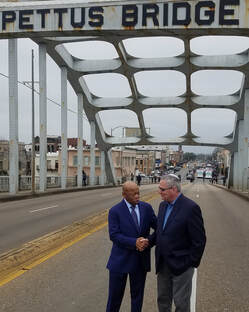 The tributes to Cong. John Lewis are richly deserved. They will focus on the public man and his admonitions to people to “get into good trouble.” And well they should. As an inspiration to activists over the course of more than sixty years, he always set the example of what my late mother-in-law, Carol Davidson, used to say: You have a mouth; use it. John Lewis felt the same way about his body, using it whenever necessary to “get in the way.” I was in no way a friend of this man, though he greeted me and treated me like one. It does not make me unusual, but it gives me a couple of unique stories to tell. I say “unique,” but that’s because they are unique to me. For John, they were typical. I have long been active in the Faith and Politics Institute, the most important organization you never heard of. Faith and Politics works primarily with elected officials and their staffs on Capitol Hill to help them actualize their individual and collective commitments to public service and personal values. Most especially, the focus has been on race (though not only on race). For more than thirty years, senators, representatives and others have joined in a pilgrimage to the civil rights south, especially Alabama, where they heard from “luminaries,” veterans of the movement. Those encounters have taken place in Birmingham, Montgomery and, on Sunday morning, in Selma. The host and guide was always John Lewis. I met him on my first pilgrimage and thereafter many, many times. I heard him speak so often, I could tell the familiar stories about preaching to the chickens, holding down the house, meeting Martin Luther King and crossing the Edmund Pettus bridge with an apple and a toothbrush in his backpack. Yet, every time he told those stories they concluded with a fresh message that drew a straight line from faith or opportunity or preparation directly to the matter at hand. No one is always right. John Lewis came close. But here are three of my stories that have less to do with John Lewis the public figure than John Lewis the man. Set aside your interest in his life of public service. Here was a life worth emulating. More than a dozen years ago, I found myself on a bus with John on our drive from Selma to Montgomery. Also on the bus was Susannah Heschel whose father, Rabbi Abraham Joshua Heschel, had marched with Dr. King in Selma. She and her husband had brought their baby along. I took a picture of John Lewis cradling that child as if it were his own grandbaby. The emotion he exuded was profound. Later that same day, we disembarked from a plane at DCA. My photograph from that moment was from behind John, just after he had gently taken the hand of Ethel Kennedy – a gesture of respect and support. Many years later, I was dispatched by my alma mater, the Jewish Theological Seminary, to deliver a letter asking John to agree to receive an honorary doctorate. Hoping simply to hand him the envelope, I made an appointment to visit his congressional office. When I arrived, he was waiting for me, and asked me to come into his private office. He brought no aide, set no time limit, ordered his calls held. He engaged me in conversation that was at once personal and respectful, setting at ease a guy still able to be star-struck at sixty. Then he opened the envelope, read the letter, and asked me about one detail it mentioned: this was Rabbi Heschel’s seminary? I said yes. He put the letter down and said, “Then I would be privileged to accept this honor.” No scheduler, no political advisor, no other question. We were finished in fifteen minutes, but he asked me if I would like to see some of the mementos on his wall. He proceeded to walk me through a gallery of photos that chronicled his presence in modern American history. To him, this casual acquaintance who came to impose on his time was, at that moment, the most important person he knew. The last time I was with John was at the foot of the Edmund Pettus Bridge. A year ago, I went on the pilgrimage again. At the end of Sunday’s march across that bridge, John volunteered to have his picture taken with anyone who wanted it. I held back – the elected officials went first, then the sponsors, finally the hangers-on. By the time I stepped up, he had taken individual photographs with hundreds of people. He was glad to see me and remembered the visit in his office and the honorary degree. Yes, we were posed for the official photo. But the guy who volunteered to use my cellphone captured the moment that you see illustrating this column. John Lewis never for a moment forgot his public responsibilities. The policy positions he took were often unpopular, and he did not shy away from the controversy he therefore had to engage. I know enough people in public service to know that is not unusual. But first and foremost, he was a man who saw the image of the Creator in whom he deeply believed in every person he met – including his opponents – and the opportunity to lift up the Divine Presence in every encounter, no matter how incidental. His was a life to emulate.
0 Comments
Leave a Reply. |
Archives
March 2023
Categories |
 RSS Feed
RSS Feed
